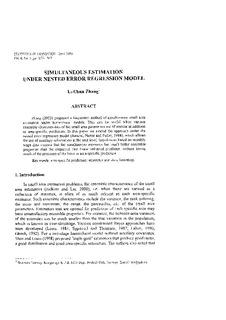| dc.contributor.author | Zhang, Li-Chun | |
| dc.date.accessioned | 2010-12-02T10:31:30Z | |
| dc.date.available | 2010-12-02T10:31:30Z | |
| dc.date.issued | 2004 | |
| dc.identifier.citation | Statistics in Transition, Vol. 6, No. 5 (2004), pp. 655-665 | en_US |
| dc.identifier.uri | http://hdl.handle.net/11250/177738 | |
| dc.description | Published with permission from Central Statistical Office of Poland | en_US |
| dc.description.abstract | Zhang (2003) proposed a frequentist method of simultaneous small area estimation under hierarchical models. This can be useful when various
ensemble characteristics of the small area parameters are of interest in addition to area-specific prediction. In this paper we extend the approach under the nested error regression model (Battese, Harter and Fuller, 1988), which allows for use of auxiliary information at the unit level. Simulations based on monthly wage data suggest that the simultaneous estimator has much better ensemble properties than the empirical best linear unbiased predictor, without losing much of the precision of the latter in area-specific prediction. | en_US |
| dc.language.iso | eng | en_US |
| dc.publisher | The Polish Statistical Association and The Central Statistical Office of Poland | en_US |
| dc.relation.uri | http://www.stat.gov.pl/pts/15_ENG_HTML.htm | |
| dc.subject | Simultaneous estimation | en_US |
| dc.subject | Estimation | en_US |
| dc.subject | Regression model | en_US |
| dc.subject | Area-specific prediction | en_US |
| dc.subject | Ensemble statistics | en_US |
| dc.subject | Bootstrap | en_US |
| dc.subject | Simuleringsmodeller | en_US |
| dc.subject | Statistiske metoder | en_US |
| dc.subject | Scientific article | en_US |
| dc.title | Simultaneous estimation under nested error regression model | en_US |
| dc.type | Journal article | en_US |
| dc.type | Peer reviewed | en_US |
| dc.subject.nsi | VDP::Mathematics and natural science: 400::Mathematics: 410::Statistics: 412 | en_US |
| dc.source.pagenumber | 655-665 | en_US |
